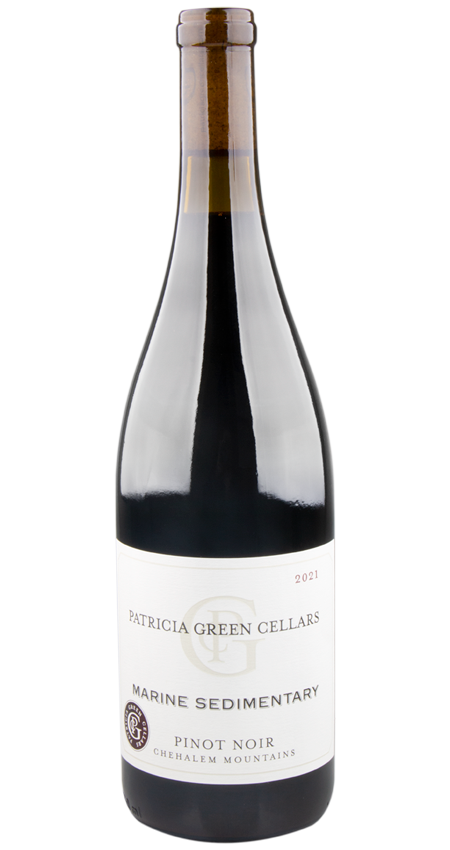Tech Notes
Wine Details
Jeb Dunnuck
International Wine Report
| Unit Size | 750.00 ML |
| Varietal | Pinot Noir
|
| Vintage | 2021 |
| Grape | Pinot Noir |
| Country | United States |
| Appellation | Chehalem Mountains |
| Region | Willamette Valley
|
| Alcohol Content | 13.50% |
By Patricia Green Cellars
2021 Marine Sedimentary Pinot Noir
Wine History
In 2005, we began bottling a small amount of wine taken from several barrels of the two vineyards we had planted on marine sedimentary soil - our estate and Whistling Ridge vineyard, also located in the Ribbon Ridge AVA. Over time, as we added vineyards like Corrine (Olenik, at the time) and Lia's, which both shifted to a Chehalem Mountains AVA (Ribbon Ridge is also considered Chehalem Mountains) and began producing larger quantities of the wine so that we could present this to a larger audience. As we increased the number of bottlings of Pinot Noir and the volume of many of those wines, it made sense to increase the production of our two Soil Series bottlings. Producing over 30 bottlings of Pinot Noir that are almost entirely composed of Marine or Volcanic soils, these wines show the root base of all the wines we make that spring from these two general soil classifications.
Production Notes
Over the years, this wine has seen a distinct evolution. Part of it is including a greater number of vineyards and blocks, which, at a fundamental level, would create a different nature for the finished wine. However, the real changes are far more important: We started making this wine in 2005, but it was only our sixth vintage farming a marine soil site and producing wines from marine soils. As this is being written in 2022, we receive fruit from four Ribbon Ridge AVA sites and four Chehalem Mountains sites just off Ribbon Ridge's eastern edge. That's eight vineyards, all within less than four miles of each other. Our understanding of the farming required to grow excellent fruit in these sites has increased dramatically over our 20 years here. Likewise, our ability to nudge the fruit toward its best self has seen a corresponding rise. Just because we source fruit from more sources in this very focused area does not make us the 'expert' on marine soil wines, but it does make us uniquely qualified to produce a wine that shows off the excellence and potential of this small part of Yamhill County.
Vineyard Characteristics
While this wine falls outside our normal winemaking pattern, as it's from an assemblage of vineyards instead of a specific vineyard site, it still retains the idea of 'place,' which is as important in the overall context. The approach to bottling certainly began with the same philosophical principles we apply to our vineyard-designated wines. Ribbon Ridge is a small hillside stretch winding up against a steep, narrow valley that winds out to the Oregon Coast. This valley was created thousands of years ago when a huge flood rolled through, leaving the area under water for a considerable period. The eastern side of the valley's hills generally faces south and southwest at elevations reaching up to 600 feet. With the Chehalem Mountains to our north, the Dundee Hills to the south, and the Coast Range only a few miles to the west, this is an isolated area where you can often see the weather systems flow around us in various directions. This little area has its own microclimate, but the soil truly sets it apart. The years of underwater exposure created a soil classification known as "marine sedimentary," of which several sub-classifications exist. This is a talc-y, dry soil set atop a sandstone sub-soil. Drainage is nearly instantaneous, and special efforts have been made to aerate, feed, and nurture the soil to promote more moisture retention. Since we do not believe in irrigating our vineyards, we've needed to proactively address the relationship between soil management and vine health, an everyday part of farming in Ribbon Ridge.
Vineyard Details
Estate Vineyard: Two barrels of Wadensvil (1997), two barrels of Dijon 114 (2001)
Corrine Vineyard: Eight barrels of Wadensvil (2007), one barrel of Wadensvil (1991), and two barrels of Coury Clone (2010)
Lia's Vineyard: One barrel of Mariafeld Clone
Chehalem Mountain Vineyard: Four barrels of Dijon 114
Wind Ridge Vineyard: One barrel of Pommard (2004)
Ridgecrest Vineyard: Four barrels of Pommard (1982)
Farming Practices
These vineyards were either organically farmed, in the latter stages of transitioning from standard farming to organic farming, or from organic farming to biodynamic farming. All Patricia Green Cellars sites are dry-farmed.
Harvest Dates
Showing the diversity that even this small area can have - as all the sites are within four miles of each other - the picking dates range from as early as September 9th to as late as October 1st. Tonnages were generally abundant, with a top-end of around 3.3 tons per acre for Estate Wadensvil and a low of 2.2 tons for the old vine Pommard at Ridgecrest Vineyard.
Vinification and Winemaking
Multiple approaches are utilized, with destemming occurring for the Corrine Coury Clone, Wadensvil, Lia's Mariafeld, Estate Dijon 114, Wind Ridge Pommard, and Chehalem Mountain Dijon 114, and 50% whole cluster fermentation for the Ridgecrest Pommard and Estate Wadensvil. Fermentations were managed by a combination of pump-overs early in the process and exclusively prior to fermentation beginning, as well as pigeages to ensure gentle handling, extraction, and delicate tannin construction. Full fermentation from the beginning to the pressing lasted 16 to 20 days. 48 to 72 hour settling prior to being racked to barrel. All wines are on full lees until assemblage for bottling. Bottled without fining or filtration.
Barrel Information
This 25-barrel bottling consists entirely of neutral barrels, with the exception of two twice-filled barrels used on the Estate Wadensvil and five on the Ridgecrest.
Technical Details
AVA: Chehalem Mountains
Soil: Willakenzie series
Tasting Notes
The 2021 vintage's surprising brightness and high-toned nature mesh nicely with this wine's inherent nature to be dark, sullen, minerally, and structured. This still provides the savory nature that fans of a certain style of Pinot Noir crave while providing a gateway to folks whose bent is still toward the volcanic soil wines.
[Information provided by Matador Vino]
2021 Patricia Green Cellars Pinot Noir Marine Sedimentary
Producer: Patricia Green Cellars
Location: USA, Oregon, Willamette Valley, Chehalem Mountains
Color: Red
Price: $48
Rating: 93
Tasting Date: 9/17/2023
Maturity: 2026 - 2036
Reviewed By: Audrey Frick
Source: 2021 Willamette Valley and Oregon Round-Up
Vibrant and lifted, the 2021 Pinot Noir Marine Sedimentary pours a youthful ruby and opens to energetic aromas of grenadine, fresh flowers, and crushed stones. Tension-packed and linear, it’s focused with bright acidity that drives the wine forward and has fine tannins and a mouthwatering finish. It is coiled and needs time to unravel. Drink 2026-2036.
PATRICIA GREEN CELLARS Pinot Noir, Willamette Valley ‘Marine Sedimentary’ 2021
Rating: 92
Value: $48
Drink: 2024-2028
Country: United States
Region: Oregon
Appellation: Willamette Valley
Editor: K. Padberg
Issue: March, 2023
This wine shows the implications of terroir. Derived from vineyards on marine soil, this 2021 bottling from Patricia Green highlights notes of fresh mushrooms and potting soil next to dark cherry and raspberry and a touch of white pepper. The body is supple and rich yet the acidity is balanced and promises a few additional years in your cellar.











